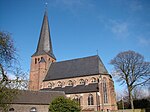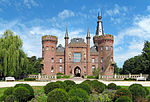Emmerich Rhine Bridge
Bridges completed in 1965Bridges in North Rhine-WestphaliaBridges over the RhineBuildings and structures in Kleve (district)Suspension bridges in Germany

The Emmerich Rhine Bridge (German: 'Rheinbrücke Emmerich') is a suspension bridge located in Emmerich am Rhein, Germany. Completed in 1965, it has a main span of 500 metres (1,600 ft), crossing the Rhine, carrying the Bundesstraße B 220, the federal highway between Emmerich am Rhein and Kleve. It is the longest suspension bridge in Germany.
Excerpt from the Wikipedia article Emmerich Rhine Bridge (License: CC BY-SA 3.0, Authors, Images).Emmerich Rhine Bridge
Emmericher Straße, Cleves Hurendeich
Geographical coordinates (GPS) Address External links Nearby Places Show on map
Geographical coordinates (GPS)
| Latitude | Longitude |
|---|---|
| N 51.829166666667 ° | E 6.2258333333333 ° |
Address
Emmericher Rheinbrücke
Emmericher Straße
47533 Cleves, Hurendeich
North Rhine-Westphalia, Germany
Open on Google Maps









